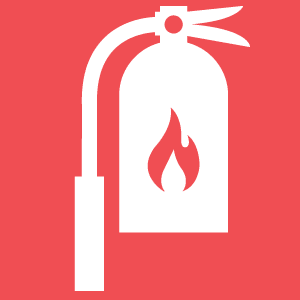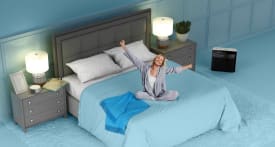Glass shower doors that suddenly shatter. Electric heaters that set the drapes, then the house, aflame. Faulty refrigerators that allow food to spoil and send everybody running to the toilet. These may sound like plot points of a bad horror flick. But they are just a few of the kinds of real-life hazards you can encounter at home, according to a Consumer Reports review of government data.
And they happen more often than you'd think. As a reporter who covers product safety, I was surprised to learn just how many people each year get injured in their homes by everyday household items. Even dishwashers can cause injuries. We based our analysis on reports made to SaferProducts.gov, the public database of the Consumer Product Safety Commission, the government agency that oversees about 15,000 types of products. Items ranging from furniture to fixtures were cited in the complaints.
Taking steps to promote home safety, while always important, is extra-critical these days because the pandemic has caused many of us to spend more time in our homes. In 2021, CR conducted several nationally representative surveys, each with more than 2,000 people, to identify home safety issues that concern Americans. Here, we go room by room to identify the problem areas and to provide expert advice on how to make your home a safe space.
Kitchen
The kitchen is the heart of the home, but it's also an injury hot spot. In the 10-year period CR analyzed, we found more than 10,000 reports of injuries that happened in the kitchen—more than any other room in the house. As you might expect, many of them are burns and lacerations—after all, it's easy to underestimate your need for oven mitts or overestimate your skills with a chef's knife. But cooking fires and electrical wiring problems were also prominent causes. And those dishwashers: Turns out when interior plastic parts warp, they can expose sharp edges that can cut people. While there isn't one single way to prevent kitchen dangers, experts recommend taking the following steps.
Avoid Slips and Falls
Tripping over an open dishwasher door can bang your shin and send you sprawling. So close it when you finish loading the dishwasher. Other good habits: If you spill something, mop it up right away; put commonly used items in easy-to-reach cabinets; and for things stored up high, use a sturdy step stool, not a chair.
Fix Old Wires
Up-to-date wiring is extra-important in kitchens because of all the gadgets we plug in there. Wiring that's not up to snuff can spark fires when those appliances power up, says Jim Nanni, associate director of appliance testing at CR. If you've lived in your home for many years and haven't had it inspected lately, have an electrician check the wiring. That's a step only 35 percent of single-family homeowners say they've done in their current home, according to CR's October 2021 home safety survey (PDF). And do a periodic self-check. One sign of trouble: A plug won't stay in.
Get Grounded
Be sure you have GFCI (ground-fault circuit interrupter) outlets in your kitchen. They are the ones with reset buttons: When they detect any variation from normal current, an internal switch cuts the flow of electricity. They're key in the kitchen because water and electricity don't play nicely together, Nanni says.
Monitor Refrigerator and Freezer Temperatures
Don't let food poisoning be the first sign that your fridge is on the fritz. Refrigerators don't always keep the temp where you want it, or the temperature display might not be accurate. Some warning signs: Your butter seems softer than normal, or there's condensation in the fridge or ice on freezer walls. Make sure that gaskets on fridge and freezer doors seal tight. And to make sure temperatures are where they belong—37° F for the fridge and 0° F for the freezer—buy separate thermometers to put in each.
Take Care With Oven Doors
Glass oven doors can shatter, according to CR's analysis of the CPSC data. One woman, for example, reported that she was taking a sheet of cookies out of her stove when glass from the oven door erupted all over her and the floor. Nanni says the cause could have been a defect in the glass, or a scratch that created a stress point exacerbated by the oven's high heat. To avoid this, keep pots and pans from banging into the glass. And never place cookware on an open glass oven door.
Good to know: Don't store a fire extinguisher under a sink. Leaks could damage the device, and it could be hard to find behind a mess of cleaning supplies.

Bathroom
Even everyday activities—showering, blow-drying, shaving—can sometimes be hazardous. That's partly because bathrooms get wet and the hard surfaces—sinks, tubs, and tiled walls and floors—can be unforgiving if you fall. There's also the unhappy mix of water and electric current. Here's how to injuryproof your bathroom.
Use Rubber-Backed Rugs
Alternatively, put a nonskid mat under a bathroom rug, says Melanie Musson, a home safety expert with US Insurance Agents, a website that allows consumers to compare insurance quotes. Whichever rug you use, choose one with a low profile. Thick or plush ones might not seem quite so luxurious if you end up with a bruise after tripping on one. Also consider putting nonslip mats in tubs and showers.
Fix Shower Doors
Yes, these also sometimes shatter. Shower and tub doors were linked to over 300 injuries in CR's analysis of CPSC data. As with glass oven doors, even minor nicks and scratches can cause stress points, making them vulnerable to breaking if, say, you hit one with your elbow while reaching for the shampoo. Glass could also shatter if doors aren't aligned properly when they are installed or if they become loose over time. So repair or replace any glass enclosure that is damaged or scratched, or that doesn't seem to close properly.
Shower Safely
Lower the temperature on your water heater to 120° F. That can help prevent scalding, according to the CPSC. (It can also help you save on your hot water bills.) And if you're a little unsteady, add a shower seat with rubber tips on the feet so you can sit while you clean yourself. Also consider installing a handheld showerhead set on a sliding bar with a 6-foot hose that you can use while you are sitting or standing.
Be Careful With Electronics
You know that blow-drying your hair while taking a bath is a really bad idea. But also dangerous: using a blow-dryer or any other plugged-in appliance if the water is merely running. If you're holding a live hair dryer or beard trimmer and it comes into contact with a stream of water from a faucet or an errant spray from a shower, you could get a jolt. Also, though you might not think of your cell phone as a major appliance, it can pack a punch if you plug it in while taking a bath and it plops into the water along with the bubbles. So as in the kitchen, make sure that only GFCI outlets are in the bathroom.
Try Grab Bars
Admit it: When you find yourself in a public restroom with a grab bar, you like having it there. So consider installing one at home, too, especially if you are a little unstable on your feet. Place it near the toilet, shower, or tub—or all three places. Having one for visitors is a really good idea, too, both for courtesy and because we live in litigious times. Or do it for your future self: Advance planning helps people stay in their homes as they age, says Geoffrey Hoffman, PhD, an assistant professor at the University of Michigan School of Nursing who has studied preventing falls. For an extra boost getting off the toilet, consider a "comfort height" seat, which is a little taller than standard.
Laundry Room
You expect fires to start in your kitchen, but your laundry room? Local fire departments respond to almost 14,000 dryer fires every year, according to a 2020 National Fire Protection Association report. A common culprit: lint, which turns out to be remarkably flammable. (In fact, DIYers on YouTube can show you how to use the stuff as kindling for your fireplace.) Washing machines with faulty wire or cable insulation can also trigger house fires. To prevent these and other hazards, follow these tips.
Clean Your Vents
Have your dryer vent cleaned and inspected annually by a professional who maintains heating, ventilating, and air conditioning systems. And clean the lint filter before each use. The NFPA estimates that about a third of dryer fires are caused by vents clogged with fibers that ignite when the dryer is running. Rick Bohdel, president of Ductz International, which specializes in dryer vents and other HVAC systems, says to watch for these signs of a clogged vent.
• It's taking longer than usual for clothes to dry.
• Just-dried clothes feel hotter to the touch than normal.
• The laundry room is starting to feel like a sauna.
Lock Up Laundry Pods
These detergent packets can look like candy to kids, but they're quite dangerous if ingested. Even touching the pods and then rubbing your skin or eyes can cause harm. From January through November 2021, there were 9,548 calls to poison control centers involving children 5 and younger who ingested or touched laundry pods, according to the American Association of Poison Control Centers. So store laundry pods on a high shelf or in a locked cabinet. If you live in a home with a child under 6 or a cognitively impaired adult, CR recommends using liquid detergent instead of laundry pods.
Bedroom
Ideally, your bedroom is your safe haven, where you can escape life's stressors. And it can be. These tips will help you sleep more safely and soundly.
Secure Furniture
That means attaching heavy furniture—think dressers, bookcases, and jumbo-sized TVs—to the wall, particularly in kids' rooms. Each year from 2017 through 2019, an average of 19,900 people went to ERs for injuries related to furniture tip-overs. And between 2000 and 2019, 351 people were reported killed in tip-over incidents, according to the CPSC. And it's not just young children: More than 11,000 adults are injured each year by tip-overs. Even expensive and seemingly well-made dressers can tip, especially when a drawer is open or a TV is on top.
Yet in CR's June 2021 wall anchors survey (PDF), less than a third of Americans said they anchor any of their furniture. So keep your furniture and TV stable. Here's how.
• When purchasing new dressers, check CR's tests to identify stable ones.
• Anchor dressers to studs in your wall, using anti-tip kits that come with the product or stand-alone kits you buy separately.
• Never use drywall anchors or toggles; they pull out too easily.
• On the furniture, attach the bracket as high as you can, preferably into solid wood.
• For TVs, use a wall mount when possible instead of putting the set on top of a dresser or another piece of furniture.
• If you can't mount the TV on a wall, make sure the piece of furniture it is on is stable and large enough to support it, and anchor the TV as you would a dresser.
Space Heater Rules
About 1,700 house fires and 80 deaths are tied to portable space heaters annually. Here are some tips for safe use.
• Place space heaters on hard, level, nonflammable flooring.
• Don't use in a child's room, and never leave one unattended.
• Keep them at least 3 feet away from bedding, curtains, and other combustible materials.
• Check cords for damage, don't use with extension cords, and consider arc-fault circuit interrupter outlets or circuit breakers. They prevent fires when appliances that draw a heavy current cause an electric arc or overheat loose connections.
• Check CR's ratings for heaters that did well in safety testing.
• Anchor furniture securely to studs in the wall to prevent it from tipping over. And unplug space heaters so they can't spark a flame overnight.
Living Areas and Stairs
Falls, fires, and freakish accidents with kids: Those are three of many homeowners' biggest concerns, and for good reason. Slips and falls are common anywhere in the house, and are especially scary around stairs. Older people, in particular, are prone to injuries and mishaps; each year people 65 and older make up over 3 million trips to emergency rooms to treat injuries related to falls, according to the Centers for Disease Control and Prevention. Most home fires start in kitchens, but fireplaces and woodstoves also pose a variety of risks, from clogged chimneys to smoky rooms to superheated glass doors. And for young children, the hazards can come from anywhere, and when you least expect them. Here's how to ward off those dangers.
Get Good Lighting
Trips and falls are more likely in the dark or even just in dim lighting. So make sure lights are working at the top and bottom of all stairways, plug in night lights in all halls, and make sure well-traveled paths through living rooms, dining rooms, and other shared spaces are well-lit.
Stay Stable
That means treads on stairs and wood or tile floors, securing large rugs to the floor with nonskid pads, and avoiding throw or area rugs, which are harder to keep secure. Make sure all electric cords run along sides of room, not out in the middle of the floor. If possible, have handrails on both sides of stairs.
Use Fire Screens
Nothing makes a home feel cozier than a roaring fire—as long as it stays where it belongs. So always use a screen to cover the opening. The glass doors on some fireplaces and wood or pellet stoves can get superhot. So never touch them with bare hands. Oven mitts or welder's gloves can protect when touching handles or emptying ash bins. Another oft-forgotten chore: Get your chimney inspected and cleaned every year. And an air purifier can remove irritating particulates.
Go Cordless
It can take less than a minute for a small child to be strangled after getting tangled in a window cord, according to the CPSC. And those accidents are often silent. So if you have young kids in your home, use cordless window coverings. Or at least move furniture away from windows, make cords as short as possible, or tie them securely back with an attractive ribbon or sash.

Outdoors
Life in our own backyards is supposed to be safe. But the tools we use to keep our yards tidy cause thousands of injuries and dozens of fatalities each year. And the pandemic means that more of us are using that equipment, some for the first time. Proper use means more than just limiting kids' access to powerful machines such as riding lawn mowers. It also means taking the right safety steps with the propane heaters, firepits, and chimineas—portable firepits with a chimney—now showing up on so many of our patios and decks.
Warm Up Safely
Firepits: Whether you gather around a portable firepit, a built-in fireplace, a chiminea, or a simple hole in the ground ringed with stones, the fire should ideally be at least 20 feet from your house or other structures such as garages and fences. Don't put them under tree limbs or electrical wires, either. When the fire is done, spread out the coals and unburnt logs as thinly as possible and douse with a hose set to a wide spray till the embers go out.
Propane heaters: It can be easy to think that these stand-up heaters, now common in outdoor restaurants and patios alike, pose little danger. But their heating elements get red-hot and can burn skin or ignite flammable materials that touch the heater, such as a windblown paper napkin or clothing. And never use gas-burning models indoors; as with generators, they produce carbon monoxide. Make sure you put them on a flat, solid, noncombustible surface, so they don't tip over—or spread fire if they do.
How to Run a Portable Generator
Don't use one in the garage or basement, or in a semi-enclosed area, such as a porch. These machines emit carbon monoxide. The CPSC estimates that each year more than 700 people die of carbon monoxide poisoning while using portable generators. Yet 20 percent of owners say they typically use their portable generator in a shed, in a garage, or indoors, according to CR's March 2021 generator survey (PDF). Take these steps to avoid carbon monoxide poisoning while using a generator.
• Place the generator at least 20 feet from your home.
• Always direct exhaust away from your home.
• Choose one that shuts off automatically if CO builds up to dangerous levels.
• Look for a term such as "CO Guard," "CO Protect," "CO Detect," "CO Shield," or "CO Sense" on the label.
• Make sure it meets one of two voluntary standards: ANSI/UL 2201 Certified for Carbon Monoxide Safety or ANSI/PGMA G300 Certified Safety & Performance.
• Read more about portable generator safety. And go to CR's generator ratings to find safe and effective portable generators.
Mow Carefully
Injuries related to riding mowers sent an average of 33,000 people to the emergency room each year between 2018 and 2020, according to the CPSC. Here's how to prevent those injuries.
• Read the instructions. It's important to understand how to use all the mower's controls before you hop on.
• Check terrain, looking especially for bumps, steep slopes, large holes, and rocks, all of which can overturn a machine.
• Don't mow wet grass, which can cause you to lose traction and control.
• Protect your feet. That means never trying to stabilize the machine by putting your feet on the ground, and wearing sturdy shoes, with laces tied tight.
• Practice good gas hygiene. Never remove the gas cap or add fuel while the engine is running, and let the engine cool before refueling. Don't refuel indoors or in the garage.

Editor's Note: This article also appeared in the March 2022 issue of Consumer Reports magazine.

















